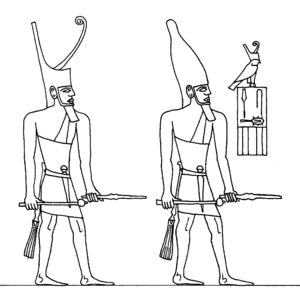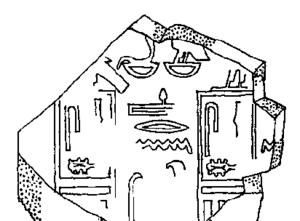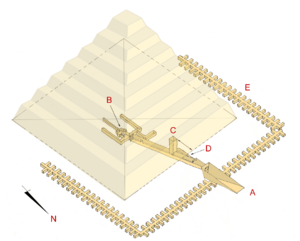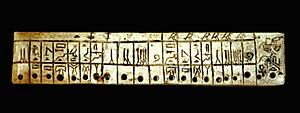Sekhemkhet facts for kids
Quick facts for kids Sekhemkhet |
|
|---|---|
| Djosertety, Djoserty, Tyreis | |

Relief of Sekhemkhet from Wadi Maghareh
|
|
| Pharaoh | |
| Reign | 6 regnal years 7 regnal year c. 2650 BC (3rd Dynasty) |
| Predecessor | Djoser |
| Successor | Sanakht (most likely) or Khaba |
| Consort | Djeseretnebti ? |
| Father | Khasekhemwy ? |
| Mother | Nimaathap ? |
| Burial | Buried Pyramid |
Sekhemkhet was an ancient Egyptian king, also known as a pharaoh. He ruled during the 3rd Dynasty in a time called the Old Kingdom. His rule is thought to have been from about 2648 BC to 2640 BC. He is also known by other names like Djoser-tety and the Greek name Tyreis. Sekhemkhet was likely the brother or oldest son of the famous pharaoh Djoser. We don't know much about Sekhemkhet because he ruled for only a few years. However, he started building a large step pyramid at Saqqara. He also left behind a well-known carving in the rocks at Wadi Maghareh in the Sinai Peninsula.
Contents
How Long Did Sekhemkhet Rule?
Historians believe Sekhemkhet ruled for about six to seven years. The ancient Turin King List says he ruled for six years. This idea is supported by how unfinished his pyramid is. Another historian, Toby Wilkinson, suggests seven years based on old records. The ancient writer Manetho also said Sekhemkhet, whom he called Tyreis, ruled for seven years.
Some people thought he ruled for 19 years. However, this is unlikely because his pyramid was never finished. Most experts agree that a shorter reign of six or seven years makes more sense.

We don't have many records of what Sekhemkhet did during his rule. The most important clues come from two rock carvings at Wadi Maghareh. This area is in the Sinai peninsula. One carving shows Sekhemkhet wearing two different crowns. The other carving shows him in a scene called "smiting the enemy." In this scene, Sekhemkhet grabs an enemy's hair and is about to hit them with a special club.
These carvings at Wadi Maghareh suggest that mines for copper and turquoise were used during Sekhemkhet's time. These mines were important throughout the early 3rd Dynasty. Other pharaohs like Djoser and Sanakht also have carvings there.
Some clay seals with Sekhemkhet's name were found on the island of Elephantine. These seals also show an unusual "Nebty name." This name might mean "The two ladies are pleased with his name." It's not fully clear if this was Sekhemkhet's own Nebty name or perhaps the name of a queen.
Sekhemkhet's Family
Sekhemkhet's wife might have been a woman named Djeseretnebti. However, her name appears without any queen's title. Because of this, experts are not sure if she was truly his queen. Her name has also been read as Djeser-Ti. This name is similar to Djeser-Teti from the Saqqara King List, which names him as Djoser's direct successor.
Sekhemkhet surely had children, but we haven't found any of their names yet. Some historians believe Sekhemkhet was Djoser's brother. If this is true, then Sekhemkhet would be another son of Khasekhemwy. Khasekhemwy was the last king of the Second Dynasty. In that case, Sekhemkhet's mother would be Nimaathap.
Sekhemkhet's Tomb: The Buried Pyramid
Sekhemkhet's pyramid is often called the "Buried Pyramid." An Egyptian archaeologist named Zakaria Goneim first started digging there in 1952. He found a sealed sarcophagus deep inside the pyramid. But when it was opened, it was empty.
The Pyramid's Design
Sekhemkhet's pyramid was planned to be a step pyramid right from the start. Its base was a square, measuring about 378 feet by 378 feet. If the pyramid had been finished, it would have had six or seven steps. It would have reached a height of about 240 feet. This design would have given it a similar slope to other famous pyramids.
Like Djoser's pyramid, Sekhemkhet's was built using limestone blocks. The monument was never finished. This was probably because the pharaoh died suddenly. Only the first step of the pyramid was completed. So, it looks like a large square mastaba today.
Underground Passages and Chambers
The entrance to Sekhemkhet's burial area is on the north side of the pyramid. An open passage goes down for about 200 feet. Halfway down, a vertical shaft meets the passage. This shaft opens to the surface. Its entrance would have been at the second step of the pyramid if it had been completed.
Where the passage and shaft meet, another hallway leads down. This leads to a U-shaped underground area with at least 120 storage rooms. This whole area looks like a giant comb. Just before the burial chamber, the main passage splits into two more storage areas. These surround the burial chamber in a "U" shape, but they were never finished.
The burial chamber itself is about 29 feet by 17 feet, and 15 feet high. It was also left unfinished. However, a nearly complete burial was found there. The sarcophagus in the middle of the chamber is made of polished alabaster. It has an unusual feature: its opening is on the front side. It was sealed with mortar when it was found. But, as mentioned, the sarcophagus was empty. We don't know if the tomb was robbed long ago or if King Sekhemkhet was buried somewhere else.
In 1950, a small, shell-shaped container made of gold was found. It is about 1.4 inches long. You can see it in the Egyptian Museum in Cairo. Also, 21 gold bracelets were found in Sekhemkhet's tomb. These gold items likely escaped being found by ancient tomb robbers.
The Tomb Complex
Since Sekhemkhet's tomb complex was never finished, it's hard to know exactly what buildings were planned. The pyramid courtyard was surrounded by a special wall. This wall was very long, about 1,850 feet, and 607 feet wide, standing 33 feet high.
The only other building found so far is the Southern Tomb. It was about 105 feet by 52 feet. Inside, there was a narrow corridor leading to a double chamber. In 1963, a burial of a two-year-old child was found in this chamber. The identity of this child is still a mystery. We know for sure it wasn't King Sekhemkhet himself. The king was always shown as a young man.
No other important buildings like a mortuary temple or a serdab (a sealed room for a statue) have been found. However, experts believe they once existed. They were probably destroyed because their stones were taken and reused in ancient times.
See also
- List of Egyptian pyramids
- List of megalithic sites




